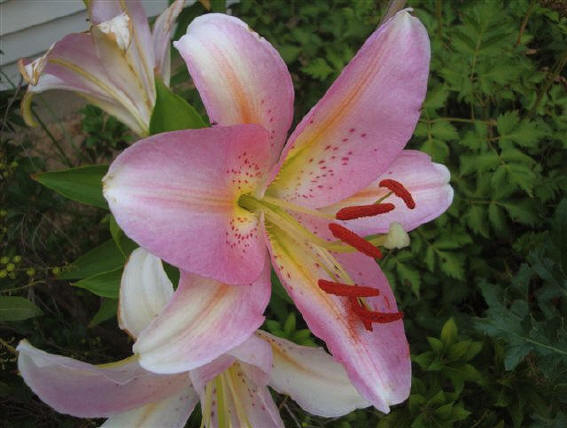Why We Love Lilies
Shirley Lindsey
Adams County Master Gardener
 As we close this chapter of "summer 2010" many gardeners are breathing a sigh of relief and very glad that it is over. Since I live in the country and our source
of water is a well, I do not water as freely as I would like to. So the result has been that many of my flowers and vegetables have suffered from the long periods of heat and lack of rain. We did, however, have an adequate supply of moisture in the spring. I believe this
enabled my lilies to be at their gorgeous best during their bloom time. The blooms lasted longer than I remember from other years. It is amazing to me that a plant with one stem can reach five feet or more and not need staking. There are dwarf varieties that are much
smaller. I have several that are now three years old, and I believe they have reached the peak of their beauty.
As we close this chapter of "summer 2010" many gardeners are breathing a sigh of relief and very glad that it is over. Since I live in the country and our source
of water is a well, I do not water as freely as I would like to. So the result has been that many of my flowers and vegetables have suffered from the long periods of heat and lack of rain. We did, however, have an adequate supply of moisture in the spring. I believe this
enabled my lilies to be at their gorgeous best during their bloom time. The blooms lasted longer than I remember from other years. It is amazing to me that a plant with one stem can reach five feet or more and not need staking. There are dwarf varieties that are much
smaller. I have several that are now three years old, and I believe they have reached the peak of their beauty.
There are several plants with the "lily" name, but they are not all true lilies. The calla lily, daylily, toad lily and surprise lily are not true lilies. Lilies grow from bulbs and are found flourishing in zones 8 through zone 4. You can buy lily bulbs in
several types including Asiatic, Oriental, Trumpet, and Turk’s Cap. There is now a variety called "orienpet" which is a cross between oriental and trumpet.

These lovely flowers come in many colors. You don’t see blue, but there are pastels as well as bright pink, orange, red, and pure white. With oriental lilies one has the added feature of fragrance. I have an Asiatic lily called Sorbet, which is white with
raspberry colored tips. As each variety bloomed, we all thought, "This is the loveliest." One of my favorites is a pure white Oriental lily called Casa Blanca. This easily reached 5 feet tall this summer. You may want to plan carefully where you plant these bulbs. This one
does best in the back of the border. But be careful not to crowd them. They need good air circulation so water will quickly evaporate from the leaves.
Lilies are not fussy about soil, and do well in average soil, as long as it is well drained. They do not flourish if they are standing in water. This spring I threw handfuls of complete fertilizer around all my perennials. It is said that lilies need sun,
but want cool feet. You can mulch lilies, but be sure not to get the mulch against the stem of the plant. The plants that performed the best for me were planted either on the east side of my house where they get morning sun, or on the south side, where the sun shines all
day. They need at least 6 hours of sun.
The best time to plant lilies is in the fall. If you plant in September or October in this area, they will have time to establish some roots before frost. The suggested depth for planting is three times the diameter of the bulb. So a bulb with 2 inch
diameter would be planted 6 inches deep. Also, space the bulbs about 10 inches apart. This will insure good air circulation. By carefully selecting species you can have blooms from late spring through fall. You can also plant lilies in pots or winter them over in pots if
you get the bulbs too late to put in the ground. The pots would need to be in a "root cellar" environment until sprouts begin to appear. As the weather warms, you can transfer the pots outside or plant the rooted lilies directly into the ground. If you plant bulbs late in
the fall, it may get quite cold, as often happens in our area. But it may not have much of a snow cover, if any. In this case it is recommended that mulch be placed over the area after the ground freezes.
One often sees lilies used in florists’ arrangements. That is because they are very long lasting when used in bouquets. When you cut lilies to bring the flowers inside, be sure to leave at least 2/3 of the stem. As with other bulbs, this is where the
nourishment comes from so the bulb will flourish another year. You may want to remove the anthers (pollen structures) so there will not be a problem with staining from the pollen. It is also suggested that you cut the flowers when they have their full color, but are just
opening.
There are several hundred cultivars available for the Asiatic and Oriental Lilies. By planting bulbs from the different types, it is possible to have lovely lilies blooming much of the summer. The bulbs will grow and produce small bulblets. If clumps get
too crowded, just dig them up and divide them. This is best done during recommended planting time for lilies, which is September or October.
Read other articles on house plants